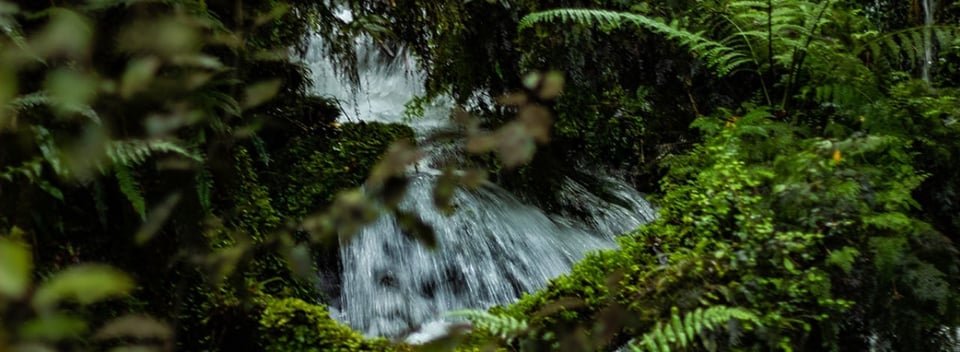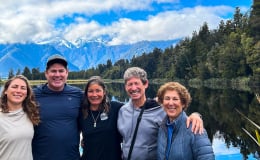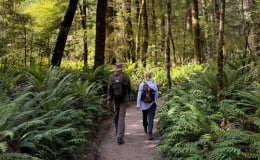
New Zealand Nature: What to Expect

New Zealand, the land of vivid green peaks, chalky blue braided rivers and wild isolated spaces teeming with life. Two words combine to forge the identity of New Zealand nature – unique and primitive. A staggering 80% of plant life and 70% of animal life here is entirely unique to New Zealand. When you step foot on our land, it is like stepping back in time. It’s majestic and quirky but you have to slow down to appreciate it. Picture Jurassic Park (without the T-Rex!). New Zealand nature is like a time capsule, step back into prehistoric time with us and take a glimpse of what our world once looked like.
Take your backpack off, stand still, observe and connect with New Zealand nature.
Why is New Zealand nature unique?
The fascinating reason as to why New Zealand is preserved in this primitive state is because everything here evolved in complete isolation. 80 million years ago, New Zealand split off from Gondwana. The near mammal-free environment allowed unique life to thrive in an environment free from predators. They were left in peace until around 800 years ago, when humans first settled in New Zealand and, over time, drove many of the beautiful beasts (like the biggest eagle in the world, the Haast’s eagle and a range of moa species) to extinction.
New Zealand animals
An intriguing fact about New Zealand fauna is that some of our native species display island gigantism characteristics. The gigantism phenomenon occurs when species are left in isolation with no constraints, so they grow larger than in other places. Haast’s eagle and moa were prime examples before they became extinct. But examples that can still be seen today are the kauri snails, huge earthworms and the giant weta. The largest weta ever recorded weighed in at 71 grams and is the world record holder for the heaviest insect on earth!
New Zealand fauna consists predominantly of birds and insects. Our New Zealand animals may not be the most intimidating or colourful but it sure is weird and wonderful!
- Frogs (pepeketua): We have four native frog species in New Zealand: Archey's frog, Hamilton's frog, Hochstetter's frog and the Maud Island frog. They are unique and primitive in their own right. Our frogs don’t have an external eardrum, they don’t croak and they don’t have a tadpole stage!
- Tuatara: Arguably our most interesting native species is the tuatara. It is the only living thing left in the world in this group of reptiles; it is the entire group of Sphenodontia. They were around in the age of the dinosaurs! Today, they are threatened with extinction.

An ecologist on Mou Waho Island with two New Zealand fauna examples - a gecko, and a weta.
Some of its fascinating characteristics are that it can live in near-freezing temperatures, can hold its breath for up to an hour and has a third eye, known as a parietal eye. Tuatara can be found across the seven islands in Cook Strait and in special predator-free sanctuaries on the mainland.
Bizarrely, we also have a whole host of flightless birds. Birds were at the top of the food chain here with the absence of predators so many lost the ability to fly.
- Kiwi: The New Zealand national bird is one of our most well-known emblems. Kiwi are nocturnal, flightless and the female lays a massive egg (a kiwi bird egg takes up 20% of the mother’s body!). There are five species of Kiwi in New Zealand; the little spotted kiwi, great spotted kiwi, brown kiwi, rowi and tokoeka.
- South Island takahē: This endangered creature is only prevalent in the Murchison Mountains of Fiordland. Their deep blue head and red beak, as well as their height (63cm) makes them very distinct. There is only around 350 of the Takahe left in the world.

A gorgeous Takahe, another fabulous example of a New Zealand animal recovering from the brink of extinction.
- Kākāpō:Another indigenous species who is also endangered (only 124 left) is the Kakapo. The world’s largest parrot (58-64cm) is both flightless and nocturnal. They are often referred to as owl parrots and can live to be 100 years old.
- Weka: These flightless birds are a much more common sighting. Weka can both run and swim fast. They feed on mice, lizards, seeds, foliage and fruit. There is a good chance of spotting these brown birds on our trips, in parts of the Abel Tasman and on the Milford Track.
Read about more of our favourite residents here including Fiordland crested penguins and Hectors dolphins.
New Zealand flora
Our plant life is just as unique as New Zealand animals. Our native trees are especially fascinating and steeped in Māori narratives.
- Kōwhai tree: The native kowhai tree is one of our most well known and distinctive flora. We even use it on our stamps! The bright yellow flowers (kowhai means yellow in the Maori language) bloom in spring and they are a treat for the retinas. They are one of the tūī birds favourite and you’ll often see them in the midst of a feeding frenzy come spring.
- Pōhutukawa tree: Up north, the pōhutukawa tree is also a feast for the eyes when in bloom. Its startling crimson filaments has made it the unofficial kiwi Christmas tree! In Maori narratives, a story tells of a young warrior named Tawhaki who tries to get to heaven to seek help in avenging the death of his father. He falls back to earth and the crimson flowers are thought to represent his blood.

The brilliant blooms of a pohutukawa tree - New Zealand nature at its finest!
- Kauri tree: The mighty Kauri are magnificent to behold. They can grow to over 50m tall, with trunk girths up to 16m. They can also live for over 2,000 years. On the Sweet North, we’ll take you to Waiomu in the Coromandel region to get up close and personal with Kauri trees. There are only a few spots left in the upper half of the North Island where you can still visit these mighty ancient trees in their natural environments!
- Ferns: Perhaps not the most exotic of flora but ferns have a special place in our hearts. We have about 200 species in New Zealand and roughly 40% of these occur nowhere else in the world. You’ll have undoubtedly came across the signature spiral of New Zealand, this emblem represents the leaves of the fern (fronds). The silver fern is one of our national symbols.
New Zealand bush
The bush in New Zealand is the indigenous forest. It consists mainly of mixed broadleaf and conifer in the North Island and native beech in the South. In Maori tradition, the bush was the home of Māori gods and spirits.
Tracks and huts weave through the wilderness so as today you can navigate the bush safely. You will get to explore the depths of the wild and enchanting New Zealand bush on your New Zealand Trails tour.
Best places to witness New Zealand nature
All of our New Zealand hiking and adventure tours provide incredible opportunities to observe and interact with nature across a diverse array of incredible locations but for specific highlights here's a list of some of our favourite spots.
- Nelson Lakes National Park: This stunning stretch of land is a mainland island, which means there is a huge recovery programme in operation to restore the area back to its natural state. You can experience its beauty for yourself as part of our Kiwi Classic on an overnight hike to Bushline Hut along Lake Rotoiti. There you will experience the beautiful beech forest, learn about the kiwi programme and go for a dip in the lake, if you are feeling adventurous!
- Coromandel: On our Sweet North tour, you will spend the day exploring the Coromandel. You’ll walk through the Waiomu Kauri Grove where one of the Coromandel Peninsula’s finest remaining kauri stands and follow it up with a stroll and a soak at Hot Water Beach.
- Fiordland: Anyone joining any of our South Island Tours will get a taste for the beauty and diversity of the Fiordland National Park. Whether you’re kayaking on Milford Sound or hiking the Routeburn Track, keep your senses alert to take in the rich flora and fauna of the area. It is home to rare birds like mohua, whio, pateke and kea.
- Mou Waho Island: The famous island on a lake, in an island on a lake, in an island on the ocean! Mou Waho has been granted special protection by the New Zealand Department of Conservation as a Scientific Reserve and is the focal point for the actions of a community-based conservation group. The island has been cleared of introduced pests, thus making it a 'safe' area for the native wildlife to live and breed.
Native birdlife that call this place home include the bellbird, fantail, New Zealand falcon, wood pigeon, tomtit, grey warbler, wax eye and weka. Mou Waho Island hiking is one of the highlights of our World Heritage Walking Tour.
Request your free New Zealand Trails brochure here to find out more about our all-inclusive, fully-guided, multi-day trips.








